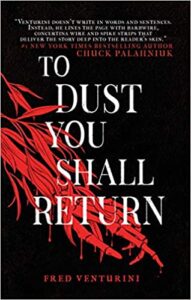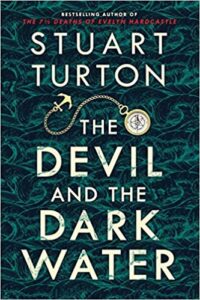To Dust You Shall Return by Fred Venturini
Turner Publishing, 2021 (release date June 21)
ISBN: 9781684426348
Availability: Paperback, Kindle ( Bookshop.org | Amazon.com )
If you only have the budget to purchase one book for the entire year, this is the one to buy. To Dust You Shall Return is superior to everything else out there, might as well just hand the author the Stoker award for best horror novel of 2021 and skip the drawn-out nomination process. It’s that good: other authors will be hard pressed to equal it.
Most of the story is set in Harlow, one of those Children of the Corn-type Midwestern towns you could drive through and not know if anyone actually lives there. Curtis Quinn, an aging ex-Mafia hitman with a price on his head, is led there while on the trail of whoever butchered his beloved wife into pieces. He suspects it’s a revenge hit to get to him, but what he finds in Harlow is much more sinister and terrifying than anything the Mafia could have dished out. Harlow residents live in fear of the Mayor, a sadistic madman (or is he?) with inhuman powers. The residents’ only hope is the legend of the Griffin, an outsider who may one day come to deliver the townspeople from the Mayor’s grasp. Could Curtis, a cold-blooded killer, be that man, and is it somehow connected to his wife’s murder?
The story scores unbelievably high on every possible level, but the excitement and originality are the two best points. After a brief prologue, the story shifts into high gear right away, and, in 352 pages, doesn’t let up. There’s never a hint of a slowdown: this is the type of book you will keep reading well into the night, until exhaustion sets in. For originality, Harlow itself is one of the most intriguing fictional towns ever invented; it’s an unusual cross between a communist community and Blake Crouch’s Wayward Pines. Residents are provided for and given jobs, but the cost is never being able to leave the town, exceept for a forays lasting a brief hour or two. The town is surrounded with razor wire and various traps to keep the people in. If they do escape, rangers track them down and return them to Harlow, where they are ritually slaughtered in front of the townspeople in extremely painful and bloody ways. This causes the book’s gore factor to run high at times, but it is always in service to the story, never gratuitous for the shock factor. That said, some of the killings are as hardcore as anything Jack Ketchum ever wrote and will make readers cower in fear, praying to forget what they just read.
The characters and plot also sell themselves by their unpredictability: the story does not go where you would expect. Numerous characters double-cross each other, and the book becomes a guessing game, keeping the story engrossing. The legend of the Griffin also helps drive the story’s unexpected twists and turns, as most stories with a creepy little town rarely use the “savior” angle. It’s just another example of what sets this story apart from all the competition. Bottom line: just buy this one, and prepare to be blown away. You won’t be disappointed. This is beyond highly recommended.
Contains: blood, gore, profanity, cannibalism, ritualistic torture.
Reviewed by Murray Samuelson







Follow Us!